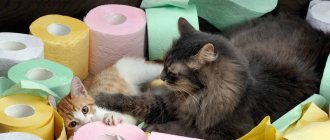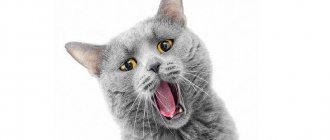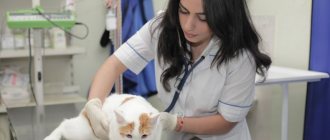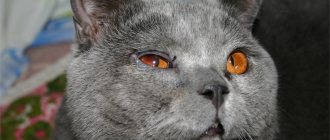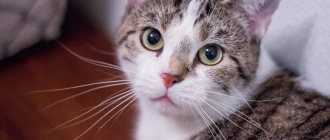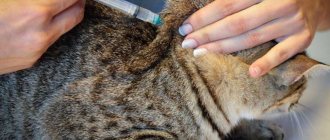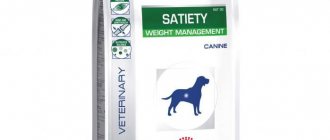Almost all owners of domestic cats periodically encounter such a not very pleasant illness as constipation in cats. Mostly older cats are susceptible to constipation, but this problem does not bypass completely healthy and young cats, and even recently born kittens.
Constipation is absent, difficult or insufficient bowel movement, which leads to a large accumulation of hardened feces in the colon, which gives the pet unpleasant and often painful sensations, and over time can lead to quite sad consequences.
Feces that are not removed in a timely manner poison the body and can lead to general intoxication , increasing the load on the excretory internal organs: stomach, kidneys, liver. Over time, progressive poisoning by decomposition products can disrupt the normal functioning of the heart and thereby lead to death.
What is constipation?
A healthy cat normally goes to the toilet once a day. Aging animals empty their intestines less often - once every 2-3 days.
Constipation in cats does not depend on gender, age or breed. It is noted that it occurs more often in cats (70% of cases in males and 30% in females) of middle age.
Insufficient defecation is a collective concept. It may mean difficult, infrequent bowel movements or its complete absence. In veterinary medicine, it is customary to distinguish 3 types of delayed bowel movements, the symptoms and treatment of which are different:
- Constipation is a partial retention of stool, when feces are released in small quantities or when difficulties arise periodically, but the cat defecates, although rarely, on its own.
- Obstipation is a serious condition in which feces clog the intestines and harden in it. The cat cannot poop on its own.
- Coprostasis - feces do not move through the intestines, complete blockage occurs.
Some veterinarians call cat constipation a symptom of systemic illnesses, while others identify them as a separate disease.
Causes of constipation
Constipation in a cat can occur for various reasons:
- In older animals, contractions of the intestinal muscles become weak, which is why they retain stool.
- Improperly balanced animal feed can lead to a similar problem: overeating bones, low water intake, reduced protein intake, dry food.
- Stressful state of the pet.
- Psychological problems: competition with other animals for the litter box, the litter box is in a crowded place, dirty cat litter.
- Pain that occurs during bowel movements. This may be associated with abdominal trauma, inflammation around the anus, or disturbances in the intestines.
- Kidney disease, after which dehydration occurs, as a result of which water is absorbed into the body, and the stool becomes quite hard and dry.
- Licking the fur can cause it to become balled up in the intestines, resulting in the need for surgical treatment of the pet.
- The presence of helminths in the body.
Provoking factors
In kittens, bowel problems are not considered a serious problem. With the transition to a new type of nutrition, this is not uncommon. It’s different for adult pets.
Most often, constipation in a cat signals the presence of illness. Therefore, if your pet does not go to the toilet for 3 days, you need to consult a doctor. In 60% of cases, the reason for the lack of bowel movements is chronic expansion of the colon (megacolon), narrowing of the pelvic canal, and nerve damage. And a breed like Manx cats has spinal cord damage.
There are other reasons for difficult bowel movements:
- Intestinal diseases (tumors, adhesions, polyps). Umbilical, inguinal hernias.
- Pelvic fracture, osteochondrosis, arthritis and other spinal problems.
- Long-term use of medications. Constipation in a cat occurs after antibiotics, long-term use of laxatives, and antispasmodics.
- After surgery with general anesthesia. If a castrated cat or a cat after sterilization cannot go to the toilet, this is a common occurrence.
- Worms. If routine deworming is not carried out and the animal spends a lot of time outside, then helminths can cause intestinal obstruction.
- Kidney and liver diseases.
- Neuralgia (pelvic nerve injury, spinal cord damage).
- Dehydration, excess calcium in the blood, low potassium levels.
Nervous constipation
In addition to physiological reasons, constipation can develop due to stress. Then they talk about neurogenic constipation. For example, an animal may not go to the toilet for several days if the living conditions have changed or due to a long move or change of housing.
Stool retention develops if the pet is not able to go to the toilet when he wants, since the tray is not accessible. The cat restrains the urge, which ultimately leads to disruption of the intestines and the formation of chronic constipation.
The problem can develop after childbirth due to stress and impaired intestinal motility. The same thing happens in sterilized cats - 3 factors play a role at once - stress, pain, narcotic drugs for anesthesia. Medicines used for anesthesia inhibit bowel function, which leads to fecal stagnation.
Alimentary constipation
Another reason why problems with bowel movements occur is poor nutrition. An increased protein content in the diet or a lack of fiber and vitamins often provokes difficult, rare passage of feces.
The diet must be balanced, especially when feeding natural foods. If the basis is dry food, then access to water is required. Incorrectly selected industrial food can also cause constipation.
Cats that eat kibble go to the toilet more often. This is due to the fact that dry cat food contains easily digestible ingredients and takes less time to digest.
Mechanical constipation
A foreign body in the intestines, for example, a bone fragment, can cause not only constipation, but also a more serious problem - volvulus.
A less dangerous option is a hair ball (trichobezoar), formed during licking. A hairball can block your stomach or intestines. Special pastes will help dissolve the hairs, and they will come out naturally.
When to give a laxative
Before you give your cat medicine for constipation, you need to understand the cause of the difficulty in defecation. There is no need to grab a laxative as soon as it seems to you that your cat rarely goes to the toilet.
Sometimes owners panic in vain, mistakenly believing that the cat is constipated.
It happens that the animal was simply starving, so she does not have bowel movements.
Or the cat has just experienced stress: a move, a fright, the arrival of a new family member or pet.
Psychological constipation caused by rejection of the tray, filler or the pet’s stressful state can be treated without the use of laxatives.
In the first case, you need to create comfortable conditions for the cat to go to the toilet: choose a secluded place for the tray, select a litter.
In the second, eliminate the cause of stress, calm the animal, and take anti-stress medications as prescribed by the veterinarian.
Constipation that develops as a result of changing food or switching to a different type of food begins to be treated with the introduction of a special diet or switching to dietary food.
You can give your cat one of the traditional medicines for constipation: a decoction of medicinal herbs, freshly squeezed vegetable juice, milk or fermented milk products.
It is not recommended to give laxative medications without consultation with the treating veterinarian.
When to give:
- After sterilization or castration surgery.
- If the cat cannot go “big” for more than 3 days.
It is prohibited to give:
- If constipation is caused by swallowing inedible objects or bones.
- If there is mucus or blood in the stool.
If your cat needs an urgent bowel movement, use an enema. No other medicine has the same rapid effect.
Causes not related to digestion
Inflammation of the anal glands is another reason for delayed bowel movements. The glands contain an odorous, viscous substance that is released in large quantities every time you go to the toilet. This is how cats mark their territory. When the glands become inflamed, they become blocked and the cat experiences pain. She begins to hold back the urge to have a bowel movement, which can result in constipation.
Inflammation can be recognized by the following signs:
- itching;
- the animal licks the anal area;
- scratches his crotch on the floor.
A preventive measure is cleaning the anal glands using the squeezing method.
Features of washing and use of prokinetics
The use of prokinetics and intestinal lavage raises many questions among animal owners. Both are undesirable at home. In many cases, colonic lavage is necessary to begin treatment. But it should be done in a clinic by an experienced veterinarian. Moreover, the procedure is carried out under anesthesia, and special equipment is used for it. Clean warm water is used for rinsing. No drugs are added to it, since they can only aggravate the situation, especially if inflammation of the mucous membranes has already begun.
Prokinetics are a whole group of drugs that stimulate intestinal smooth muscle. They cannot solve problems associated with impaired motility, and in the presence of partial intestinal obstruction, these drugs are contraindicated.
In this group, until recently, the only drug with proven effectiveness was considered cisapride, but it is currently banned in most countries due to the large number of side effects. There is a relatively new drug, prucalopride (Rezolor), which is also considered effective for cats. Studies have shown that after the first dose, it increases the frequency of bowel movements. But this drug can only be prescribed by a veterinarian.
Important! For temporary rather than chronic constipation caused by poor diet, intensive drug treatment is not justified. The risk of side effects is too high.
Many veterinarians believe that if constipation is caused by poor diet, diet correction and symptomatic treatment are sufficient.
Signs
Symptoms of constipation in a cat depend on the severity of the disorder. Normally, adult cats go to the toilet every day. However, this process is individual and for some pets the norm is once every 2 days. Feces should be moist. If the stool is dry, cracked, comes out in layers or rounds, emptying occurs once every 3 or more days - these are signs of constipation.
The longer the constipation, the denser and drier the stool.
You can tell that a cat has constipation based on other symptoms:
- the urge to go to the toilet is frequent, the cat strains, but does not defecate;
- the pet sits in the tray for a long time, meowing pitifully;
- discharge of dry feces in small quantities, possibly with blood;
- increased body temperature;
- belching, seething in the stomach, in severe cases, nausea, vomiting;
- apathy, fatigue;
- refusal to eat;
- the belly is hard, when you touch it with your fingers, the animal experiences pain;
- the anus is swollen and inflamed;
- the pet stops licking itself.
External signs are flaking on the skin, the coat does not shine and becomes dull.
Animals with chronic constipation may develop diarrhea or spotting. This is due to the irritating effect of feces on the intestinal mucosa.
Long-term problems with stool affect almost all organs and systems of the body. Gradually the animal loses weight, to the point of anorexia. Dehydration, exhaustion of the body, and enlarged lymph nodes in the abdominal cavity may occur. Microorganisms accumulate in the intestines above normal levels and intoxication occurs.
It is important to be able to distinguish the symptoms of constipation from intestinal obstruction caused by blockage or volvulus. If your cat is constipated, symptoms will appear gradually, as opposed to rapidly developing signs of volvulus.
Causes
Stool retention occurs in animals for many reasons. Sometimes this problem is temporary and depends on the psychological state of the pet. In this case, everything often returns to normal after the cat stops being stressed.
Constipation in cats is divided according to the mechanism of development into:
1) Organic - feces are retained in the intestines due to physical barriers. These are tumors, scars, and other neoplasms.
2) Functional - the cat does not go to the toilet due to deterioration of intestinal motility. The reasons for this are chronic diseases of the gastrointestinal tract, metabolic disorders, sedentary lifestyle, and inappropriate food.
Most often, problems with bowel movements are a symptom of many chronic diseases. Inflammation of the gastrointestinal tract can develop due to poisoning, monotonous diet, parasites, infections, allergies, adhesions, tumors in the intestines, beoar (wool) stones formed from the cat’s own hair, which she licks, kidney pathologies, exposure to medications, pregnancy of the cat, sterilization (castration).
When the cat becomes ill, it becomes aggressive or, on the contrary, lethargic, vomits, and loses its appetite. In severe cases, the animal may develop intestinal obstruction, which dramatically increases the risk of death.
Constipation sometimes signals pancreatitis. In this case, the animal often passes gas, and there is pain in the abdomen (he does not allow the belly to be stroked, the abdomen is tense and bloated). The animal screams in pain.
Problems with bowel movements arise due to low-quality food, which is low in fiber and protein.
Dystrophy is also manifested by constipation. At the same time, the animal loses a lot of weight, has poor hair, and mucous membranes that are bluish in color.
When an animal is infected with parasites, constipation gives way to diarrhea, the stomach becomes large, and the animal itself loses weight, despite the increased appetite.
Problems with stool can provoke poisoning of the animal and inflammation of internal organs, since feces are a source of intoxication.
How to help a cat at home
In the first stages, when the problem has not started, the owner can help his pet himself.
Ways to combat constipation in cats at home:
- Abdominal massage
The essence of the procedure is to lightly press your fingers on the stomach and massage clockwise. To achieve results, you need to massage regularly and for a long time. If after a massage your stomach gurgles, this is a good sign. If a day has passed and the cat has not gone to the toilet, they resort to laxatives.
- Condensed milk
Many owners write in their reviews that condensed milk can loosen the intestines. All you need to do is dilute condensed milk with raw water (1:1 ratio) and give it to your cat.
- Oil
Vaseline oil lubricates the intestinal walls, softens its contents, and improves peristalsis. The product is given at the rate of 20 ml per 5 kg of animal weight using a syringe without a needle. If after 4 hours the situation does not change, another 5 ml of oil is injected.
The drug can be given every hour. However, the total dose should not exceed 40 ml. The fact is that Vaseline oil envelops the intestinal walls, and the resulting film interferes with the absorption of nutrients.
Flaxseed oil will also help get rid of constipation. It does not cause harm, but on the contrary, has a beneficial effect on the irritated intestinal mucosa. Olive and sunflower oils are suitable for cleansing.
- Laxatives
When constipation occurs in a cat, treatment can be carried out with laxatives. Duphalac, Lactusan are suitable.
Preventing constipation in cats
For prevention, it is recommended to give prebiotic supplements. If you follow the instructions for use, they are harmless to the animal.
One example prebiotic supplement is Viyo Reinforces. It consists of inulin and fructooligosaccharides. With its help you can improve the functioning of the gastrointestinal tract. When prebiotics enter the body, they increase the number of beneficial bacteria and strengthen the immune system. The additive also has several additional properties - it prevents urolithiasis, makes the coat healthy and shiny. The product is easy to use. They just need to water them with the pet’s usual food. Cost – about 500 rubles. per pack of 7 sachets.
Another prebiotic feed additive is Vetelact. The product normalizes metabolism in the gastrointestinal tract, restores beneficial microflora, activates the immune system, and eliminates constipation. The drug is especially useful during antibiotic therapy, because with the help of Vetelakt you can prevent the occurrence of dysbiosis. Cost - about 150 rubles. per bottle of 20 ml.
Other preventive measures for constipation in cats:
- If the cat has long hair, then it needs to be brushed periodically. With this simple measure you can prevent the ingestion of some fur.
- It is recommended to regularly give the animal cleansing phytomins. They are usually produced in the form of paste or tablets. These products will help remove hair, relieve inflammation, and normalize the gastrointestinal tract.
- It is important that your cat drinks enough water daily. If the animal refuses to drink, it must be given water from a syringe. It is also worth paying attention to the special fountains that are on sale. Of these, cats drink more readily.
And another important factor is movement. An active lifestyle can prevent constipation and improve intestinal motility. In order for the animal to move more, it is worth buying various small toys or play complexes for it.
Diagnostics
If the problem is long-term and treatment at home does not work, you need to contact a veterinarian. Usually, an examination and interview with the owner is enough to diagnose the animal.
If a foreign body is suspected, improper bone healing after a fracture, tumor, narrowing of the intestine, protrusion of the rectal wall, a manual examination of the rectum is performed.
In case of frequently recurring cases of constipation, laboratory tests are carried out to exclude diseases of internal organs and systems.
Prescribed:
- Clinical analysis of blood and urine.
- Study of thyroid function.
- X-ray of the abdominal cavity (to detect tumors, foreign bodies, fractures).
- If a tumor is suspected, ultrasound of the abdominal cavity and biopsy.
What you need to know about constipation: symptoms and first aid
There are certain medical standards according to which a cat’s bowel movements should occur at least every two days. If this process is associated with any difficulties, if the animal receives enough food, and the volume of feces decreases, we can talk about the presence of constipation. This is most often experienced by older animals. Additionally, studies show that female cats are more likely to experience constipation than male cats (possibly due to an enlarged prostate gland).
Symptoms of constipation, in addition to the obvious difficulty with bowel movements, include:
- lethargy, apathy, depressed state;
- the appearance of swelling on both sides of the anus;
- lack of appetite, sometimes even refusal to eat;
- the formation of ribbon-like feces with a pungent odor, often mixed with blood.
If these signs appear, you should contact your veterinarian. This is especially true in cases where vomiting occurs or the temperature rises greatly.
Important! No medications, including saline laxatives and bisacodyl, should be given without a veterinarian's prescription.
Before visiting the doctor, it is recommended to give your cat plenty of water, but it is better to limit food intake. The use of an enema in such situations is a controversial issue. Some experts believe that the liquid will be absorbed by the intestines, this will lead to flatulence, and the animal’s condition will worsen. Washing, which is done in veterinary clinics, is less stressful for the pet, and at the same time is more effective.
The veterinarian will definitely order additional examinations. One of the most informative methods is radiography using a contrast agent. It allows you to check the permeability of the intestines, and can also show the cause of coprostasis. An ultrasound of the abdominal cavity and other necessary studies are performed. Based on the diagnostic data, the veterinarian makes a decision on surgical intervention.
Treatment of constipation
Treatment for constipation in a cat depends on the causes of constipation. The main goal of therapy is to soften stool and remove it from the intestines.
If this is an isolated case, and it happened for the first time, then medications are not prescribed. If cases of defecation retention are frequent, the following methods are used:
- Water enema at the rate of 5-10 ml of water per 1 kg of animal weight. Enema with physiological saline solution with the same calculation of proportions. Enema with Vaseline oil for a cat. You can do an enema with Duphalac.
- Abdominal massage.
- Taking oral laxatives for cats.
- Medicines that promote the movement of feces through the colon (Bisacodyl suppositories or glycerin suppositories for children). Suppositories are used alone or together with oral laxatives.
- Increased physical activity.
- Changing the feeding diet: introducing coarse wheat bran and canned pumpkin into the feed.
- Switching to food for cats with digestive disorders. Many brands have such lines, for example, Hill's ID, Royal Canin Fiber Response, etc.
Mild degree
When constipation occurs for the first time, a diet with a high fiber content (psyllium bran, wheat, cereals) is prescribed. Bran is added to the food - 1-2 tablespoons per serving of food.
Before introducing fiber into the diet, give the cat plenty of water to enhance the effect and prevent the accumulation of fiber in the intestines. Typically, most cats benefit from dietary fiber to help cope with the problem.
If constipation occurs again in a cat, Vaseline oil (pure or mixed with milk) or a laxative based on cisapride is recommended: Peristil, Coordinax - 0.1-0.5 mg per 1 kg of body weight.
Average degree
In case of frequent relapses, it is recommended to treat constipation with lactulose-based laxatives: Duphalac, Portalac, Goodluck and increase the fiber content in the diet. The cat is given a laxative every 8 hours at a rate of 0.5 ml per 1 kg of its body weight. The substances in the composition increase the secretion of fluid in the intestines, which facilitates the passage of feces.
If the problem persists, the laxative Bisacodyl and prokinetic drugs Ranitidine or Nizatidine, which stimulate the motility of the digestive organs, are additionally prescribed. However, Bisacodyl should not be used daily. Long-term use of the drug is detrimental to the nerve cells of the intestinal lining.
In difficult cases, hard feces are removed using enemas. Sometimes, if the feces are very dry, the veterinarian will perform a manual bowel cleanse. The cat is given plenty of fluids and anesthetized using an endotracheal tube. Then a saline solution or warm water is introduced into the intestines and the hardened stool is manually kneaded.
If a cat has constipation accompanied by flatulence, then the gases are removed through a probe and then the cat is given Vaseline oil. Pain syndrome is eliminated by Spasmalgon or No-shpa.
If drug treatment does not help, surgery is performed to remove part of the colon.
Choosing a laxative for a cat
Laxatives help relieve constipation, but their uncontrolled use can lead to unwanted effects. Let's look at the main types of medications and traditional medicine recommended by practicing veterinarians.
Medications
Based on its composition and type of effect on the animal’s body, cat laxatives are divided into several large groups.
- Bulk-forming laxatives.
- Osmotic laxatives.
- Lubricants.
- Stool softeners.
- Laxatives with a stimulating effect.
- Enema.
Bulk-forming laxatives
These are drugs that pass through the cat’s gastrointestinal tract in an undigested state. In the large intestine, they expand due to the absorption of water - the animal’s stool becomes softer and larger. This group of drugs has a long period of action - from 12 to 72 hours. Drinking plenty of fluids is prescribed for the entire course of taking the drug.
Indications: chronic constipation and its prevention; irritable bowel syndrome, hemorrhoids, anal fissures, pregnancy.
Dosage: 0.5 teaspoon for each meal. The dose of the drug is gradually reduced.
You should not give it: if the animal requires emergency help, it is better to use another type of means.
Contraindications and side effects: individual intolerance and allergic reactions. They affect the absorption of other drugs.
Recommended drugs:
- Metamucil (Metamucil),
- preparations based on flax seed.
Osmotic laxatives
This type of medication works by pulling water from the cat's body into the large intestine. Therefore, while taking them, it is necessary to monitor compliance with the drinking regime - the cat should drink a lot. The increased volume of feces with the help of liquid puts pressure on the intestinal walls, causing the urge to defecate.
The composition of osmotic laxatives is based on lactulose, which acts at the level of the colon. Lactulose suppresses the growth of pathogenic flora and forms beneficial intestinal microflora. The laxative effect occurs within 24-48 hours.
Indications: acute and chronic constipation, dysbacteriosis, postoperative period (sterilization).
Dosage: 0.5 ml per 1 kg of live weight 2-3 times a day.
Should not be given: for emergency use.
Contraindications and side effects: chronic renal failure. With prolonged uncontrolled use - loss of electrolytes, dehydration.
Recommended drugs:
- Lactusan (syrup or tablets);
- Duphalac (powder or syrup).
Lubricants
Preparations with a lubricating effect are most often used to combat hairballs. So-called malt pastes lubricate the intestinal walls, facilitating the natural removal of hairballs from the body. The composition of lubricants includes vitamins: A, E, D.
Recommended drugs:
- GimCat Malt-Soft Paste Extra;
- Beaphar Malt Paste;
- TRIXIE Malt'n'Grass.
This group of laxatives also includes vaseline oil and products based on it. The oil included in their composition envelops the intestinal walls, helping to remove foreign bodies, bezoars, and hard stones.
Vaseline oil is a safe and gentle product. It is not absorbed, does not accumulate in the body, and does not cause allergic reactions. Once in the cat's body, the oil creates a slippery film on the intestinal walls. This helps to naturally remove accumulated stool. Vaseline film prevents toxins from being absorbed and prevents the development of intoxication in the animal’s body. The laxative effect occurs after 3-6 hours.
Indications: episodic constipation, postoperative period (sterilization/castration, abdominal surgery), postpartum period, coprostasis.
Recommended dosage: 1 ml of oil per 1 kg of live weight after 8-10 hours.
Should not be given: for chronic constipation.
Contraindications and side effects: intestinal bleeding, hemorrhoids in the acute phase. In case of long-term use, the reflex to defecation may decrease. Reduces the absorption of fat-soluble vitamins (A, D, E).
Recommended drugs:
- Bimin;
- Vaseline oil.
Stool softeners
The effect of the drugs is due to the salts included in their composition. They reduce the surface tension of the animal's stool, allowing it to better absorb water. Emollients can be used very carefully, only as directed by a veterinarian (prescription). The effect occurs within 3-6 hours.
Indications: intoxication, episodic functional constipation, bowel cleansing before abdominal surgery (sterilization).
Dosage: strictly as prescribed by the doctor.
Do not give: if the cat requires long-term treatment.
Contraindications and side effects: pregnancy, lactation. With prolonged uncontrolled use - an uncontrollable laxative effect.
Recommended drugs:
- Docusate sodium is a fast-acting laxative.
Laxatives with a stimulating effect
Stimulant laxatives act by irritating the muscles of the colon, thereby increasing its activity. Prevents hardening of feces. They are characterized by fast action. Prescribed by a veterinarian. The effect occurs 6-10 hours after administration. The duration of use should not exceed 7-10 days. Uncontrolled use may cause dehydration.
Indications: acute constipation.
Dosage: calculated individually by a veterinarian.
Should not be given: for chronic constipation.
Contraindications and side effects: pregnancy, lactation. With prolonged uncontrolled use, “lazy” bowel syndrome is formed, chronic constipation develops, and the risk of tumors in the colon increases.
Recommended drugs:
- Bisacodyl is a strong laxative.
Enema
A cleansing enema helps clear the cat's intestines of stagnant fecal matter. An enema is done with warm boiled water or chamomile infusion. It is best not to do it yourself at home, but to entrust this procedure to specialists.
Important!
Human laxatives are not suitable for cats.
Folk remedies
In addition to medicines, the following are used in folk medicine:
- Pumpkin. Freshly squeezed natural pumpkin juice is a natural laxative for cats. The juice is mixed into food or poured into the animal’s mouth using a syringe. The recommended single dose is 0.5 teaspoon. As a preventive measure, a little boiled pumpkin is included in the animal’s daily diet. For convenience, boil the peeled pumpkin for 7-10 minutes and grind in a blender to a puree.
- Milk. The most common folk remedy with a laxative effect. Milk is given warm several times a day. Do not give to cats with lactose intolerance. In large quantities it can cause diarrhea.
- Condensed milk. Condensed milk diluted with raw water (from the tap) acts as a laxative. Condensed milk is diluted with water in a ratio of 1:3. The resulting mixture is given to the cat one tablespoon at an interval of 3-4 hours, no more than 5 times a day. This method should not be abused. This method is not used in cats with diabetes.
- Olive, flaxseed and coconut oil. A small amount of oil (¼ – ½ teaspoon) is mixed into the animal’s food. Vegetable oils should be given in doses and with great caution - they negatively affect liver function.
- Psyllium seed husk is a natural enterosorbent that restores intestinal microflora. The husk is crushed in a coffee grinder or blender and mixed into cat food, ¼ - ½ teaspoon per meal.
- Unhulled oat grains have a mild laxative effect. Add 50 grams of grains to a glass of milk and boil for 30 minutes. Cool the finished broth to room temperature and give a teaspoon 2 times a day.
- Oat bran is a good source of fiber, an analogue of the drug Metamucil. Give half a teaspoon with each meal. Long-term use is allowed.
- Decoctions and infusions of herbs: rhubarb root, buckthorn, borage, knotweed, elderberry, flax seed, centaury. A tablespoon of dry herb is poured into a glass of boiling water and left in a water bath for 20 minutes. The resulting broth is cooled for half an hour, filtered, squeezing out the raw materials. Bring the infusion to 200 ml by adding warm boiled water. Give 1-2 teaspoons 3-4 times a day.
If the cat does not have a bowel movement within 8-12 hours after taking the folk remedy, it must be taken to a veterinarian for a diagnosis and treatment.
Herbal remedies for constipation
Collection No. 1
- Peppermint leaves – 1 part;
- Pharmaceutical chamomile – 1 part;
- Stinging nettle – 1 part;
- Horse sorrel – 1 part.
Collection No. 2
- Buckthorn bark – 3 parts;
- Stinging nettle – 2 parts;
- Yarrow – 1 part.
Herbal teas are prepared and used in the same way as herbal decoctions.
Important!
According to veterinarians, it is better not to use vegetable oils. They are absorbed into the intestines and cause pain. An overdose of vegetable oils causes problems with the liver.
How to help kittens with constipation
A kitten's unstable digestive tract can react by delaying bowel movements to the slightest error in nutrition. The normal stool frequency for kittens is at least once a day. If you notice signs of constipation: hard feces, painful bowel movements, hard belly, you should:
- find the reason
- perform a first aid.
To determine the cause, the kitten is shown to a veterinarian. Before visiting the clinic, you can use one of the following proven methods:
- drink milk or condensed milk diluted in raw water;
- adjust the water balance, offer the kitten something to drink, and if it refuses, give it something to drink using a syringe;
- massage the tummy with light longitudinal movements from the chest to the tail, it is best to do this with a moistened cotton pad - this is reminiscent of the licking of a mother cat;
- give vaseline oil - 0.5 ml per 1 kg of weight 2-3 times a day;
- make an enema with chamomile infusion using a small syringe or syringe (10 ml) - lubricate the tip with Vaseline;
- put a rectal suppository made from a small smooth soap soaked in water.
It is strictly prohibited to independently select medications for a kitten. All medications must be prescribed by a veterinarian.
Kittens are prescribed mild laxatives based on lactulose in powders or syrup with a safe effect.
Recommended drugs:
- Vetelact;
- Lactusan;
- Duphaston;
- Prelax.
The drugs are given orally using a syringe or mixed into milk. The powders are pre-diluted in a small amount of boiled water at room temperature. The recommended dosage for kittens is 0.25 ml per 1 kg of weight 2-3 times a day.
Laxative in the postoperative period
After sterilization (castration), due to the use of strong anesthetic drugs, the animal experiences difficulty in bowel movements. To prevent bleeding and suture dehiscence, the doctor prescribes laxatives and prescribes a special postoperative diet.
What to give?
To help your cat restore the process of defecation, you can use Vaseline oil or the laxative Duphalac in syrup. To do this, oil or medicine is drawn into a syringe without a needle at the rate of 0.5 ml per 1 kg of animal weight.
Danger of constipation
Constipation in cats can recur after treatment, and in 15% of cases they cannot be cured. The owner must be aware of the possible consequences:
- dysbacteriosis;
- constant intoxication;
- pain;
- metabolic disorders, especially vitamins B12, biotin, folic acid;
- the most serious consequence is colorectal cancer.
With chronic constipation, a cat may not go to the litter box, as it associates it with pain.
Treatment of constipation in a cat in a veterinary clinic
Treating constipation in a cat begins with diagnostic procedures. Doctors in a veterinary clinic conduct x-rays, ultrasound examinations, and take blood samples for analysis. The results obtained allow us to find out the exact cause of constipation.
The next steps depend on the diagnosis. If a foreign body is detected, surgical intervention is prescribed. If your cat's constipation is caused by fecal buildup, veterinarians will give an enema. If necessary, any medications can be administered - to relieve the inflammatory process, treat the liver, restore normal functioning of the gastrointestinal tract, etc.
Prevention
The best way to control the problem is prevention. Simple rules help reduce the risk of relapse:
- Regular combing of hair should be a mandatory procedure for caring for your cat.
- After treatment, nutritional adjustments are made with increased fluid intake. The pet needs to be fed foods with fiber and added vitamins and minerals.
- If possible, transfer from dry to wet food.
- Do not expose the animal to stress.
- A cat's life should be active. The cat is forced to move and play more.
- Give your pet a paste with cleansing phytomins.
- In the postoperative period, introduce probiotics into food.
What to give your cat for constipation: types of laxatives
There are different classes of laxatives. They differ in their mechanism of action. The following funds are available:
- lubricating Liquid paraffin belongs to this group. It is administered orally, a maximum of 2 ml twice a day. This should not be done with a syringe, as this can lead to serious complications. This group also includes soy lecithin, maltose dextrin, vitamin E, etc. These products are produced in the form of a gel, which is administered orally in very small quantities 1-2 times a day,
- osmotic agents. The most popular drug in this group is lactulose. Its daily dosage is 0.5-1 million per 1 kg of animal weight,
- motor stimulants. The most effective and safe drug is bisacodyl 5 mg at a dosage of 0.5-1 tablet per day,
- topical medications that are administered directly into the rectum using a pipette. These are sodium citrate, sorbitol, and other similar agents, the mechanism of action of which resembles osmosis, but local,
- stool softener supplements. These are wheat bran, psyllium powder,
- warm water to rinse the intestines. Some owners believe that a soap solution or iodine should be added to such a liquid, but in reality this should not be done.
The doctor decides what to give the cat for constipation, taking into account the condition of the animal, as well as the identified causes of coprostasis.
Important! The use of laxatives in the medium to long term is considered undesirable because their effectiveness decreases over time. In addition, they can cause irritation of the intestinal mucous membranes.
The features of some of the listed funds will be discussed below.
Stool retention in kittens: reasons
Constipation in a kitten is a common problem that every owner should be prepared for. It occurs especially often in artificial kittens that are raised without a mother.
A kitten fed by a cat rarely has problems with bowel movements. Newborn kittens cannot empty their bowels on their own. Their mother helps them. She licks the stomach and anus and thereby stimulates peristalsis.
Immediately after birth, kittens' intestines are sterile. The colostrum they receive from their mother fills it with beneficial bacteria. If the baby is bottle-fed, then he does not receive these bacteria and, due to dysbacteriosis, problems with stool may develop. Moreover, constipation in a newborn kitten occurs regardless of what it is fed: milk, baby food or cat milk replacer.
The intestines of a week-old kitten digest only milk. When switching to artificial feeding, both delayed bowel movements and diarrhea are equally possible. Both conditions are dangerous: constipation causes body poisoning, and diarrhea leads to dehydration.
At 1 month, when complementary feeding begins, constipation is an expected phenomenon. The diet changes, is replenished with food, and the microflora has to adapt to digest new substances.
At 2 months, vaccination is carried out, which can also upset the balance of microflora and provoke a delay in bowel movements in a small kitten.
When feeding natural food, constipation in kittens occurs when the diet is unbalanced, especially when the fiber content is insufficient.
Kittens are active and inquisitive. A common cause of obstruction is ingestion of a foreign body.
Laxative stool stimulants
The drugs in this group are strikingly different in their properties and chemical structure from other groups of medications. The active substance included in the medicine stimulates the muscles of the intestinal wall.
The result of the reaction is increased peristalsis of the large intestine. In case of an overdose of the drug, strong, very painful spasms of the smooth muscles of the digestive tract may occur.
Contraindications for the use of this group:
- Constipation in kittens whose intestinal muscle layer is underdeveloped and has a tendency to intussusception.
- Pregnant cats (the drug may cause miscarriage).
- Congenital organic malformations of the digestive tract (for example, short bowel syndrome).
With prolonged use, secondary lazy bowel syndrome often develops, in which stool without a laxative becomes impossible. For this reason, only a veterinarian can prescribe the drug and calculate the individual dosage.
What medications are given during surgical treatment?
If therapeutic and dietary measures are not enough, surgical intervention may be performed. Surgeries are also practiced in cases where constipation is caused by foreign bodies and tumors, various injuries to the intestinal walls and pelvic canal. Such interventions are carried out only in a clinical setting.
And in the postoperative period, the animal must be given antibiotics. The best option is a combination of drugs, for example, cephalexin and metronidazole. During the first time after surgery, the animal is limited in food, but it is advisable to restore normal feeding as quickly as possible. The frequency of bowel movements during this period increases without the use of the means described above, and the stool usually has a very soft consistency, but nothing needs to be done about this, the situation normalizes itself.
General information
But first you need to understand what constipation is. This is the name of a pathological condition in which formed feces are not excreted from the animal’s body.
And the reasons for this phenomenon are extremely diverse.
But all of them can be divided into three large groups:
- Constipation caused by some foreign body in the lumen of the large intestine.
- Pathologies that arise due to compression of the intestines from the outside (i.e. from the abdominal or pelvic cavities). Adhesions, poorly healed fractures, benign or malignant tumors are usually to blame.
- Finally, constipation of functional origin. They develop due to dehydration, decreased peristaltic activity of the digestive system and similar factors. The case we describe can be attributed precisely to this group.
Constipation in the postoperative period can be acute or chronic. The first type develops quickly, suddenly, the animal cannot defecate at all. Chronic constipation develops gradually and at first is expressed only in slight difficulty in defecation. Note that acute stool blockage in the postoperative period is more “physiological,” while the chronic type may be a sign of adhesions and other severe pathologies.
The symptoms of the pathology are very similar in all cases: the pet constantly runs to the litter box, sits for a long time, strains, meows loudly, but cannot relieve itself.

